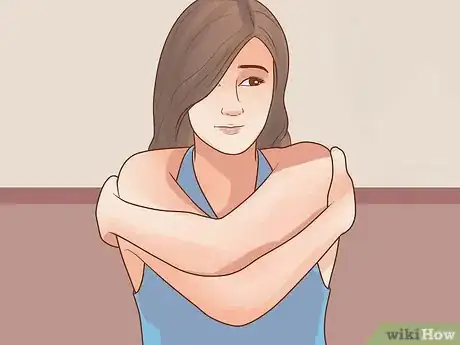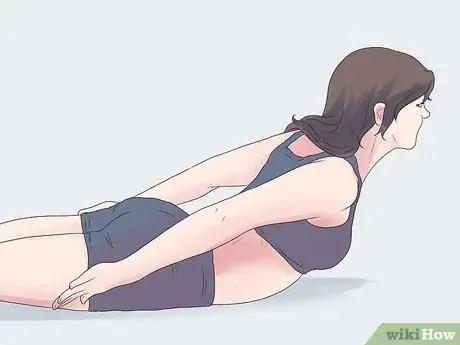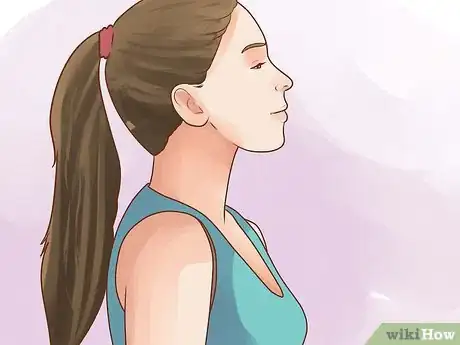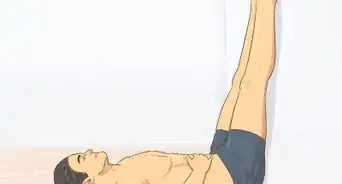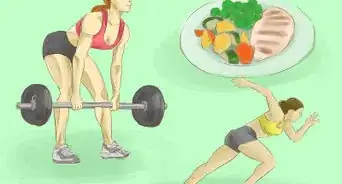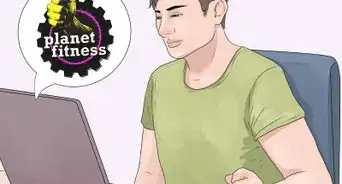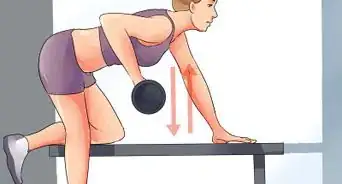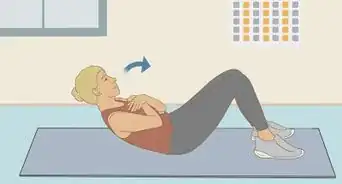This article was co-authored by Eric Christensen, DPT. Eric Christensen is a Physical Therapist based in Chandler, Arizona. With over a decade of experience, Eric works in both orthopedic and neurological fields and specializes in custom orthotic prescription and casting, vestibular reprogramming, and manual therapy. He holds a Bachelor’s degree in Exercise Science with a focus in Sports Medicine from Colorado State University and a Doctor of Physical Therapy from Regis University. In practice, Eric takes a developmental approach to rehabilitation utilizing the Selective Functional Movement Assessment. He uses functional movement patterning and manual therapy to return patients to prior levels of function.
There are 11 references cited in this article, which can be found at the bottom of the page.
This article has been viewed 400,982 times.
As we age, our joints and muscles become less flexible. You may notice that your body feels stiff in the morning when you wake up from a heavy sleep, that you've developed new pains in your shoulders or back, or that you can't quite reach your arms as high up as you used to without pain. Fortunately, there are ways to regain the flexibility most of us naturally enjoy during our youth. Flexibility improves circulation, muscle health, and endurance[1] , can help prevent injury, and perhaps even ward off arthritis and osteoporosis.[2] Becoming more flexible involves daily routines and exercises designed to stretch the muscles and joints.
Steps
Flexibility Exercises
-
1Target your shoulders. In order to gain flexibility in your shoulder muscles, you must target stretches in both the shoulder area and its mirror area in the chest.
- Stretch your chest muscles and concentrate on this stretch. Reach both arms behind your back and clasp your hands together. Hold it for ten to twenty seconds, raising your arms into the stretch.
- Stretch each arm as far across your chest while holding it as you can without feeling pain for at least twenty seconds each day.[3]
-
2Stretch your hamstrings. Because this is a vulnerable muscle often injured by athletes, take extra care to stretch it after you are warmed up.
- Sit on the floor with one leg extended in front of you and the other bent. Reach forward with the hands and grab the foot on your extended leg, leaning into the stretch in the back of your thigh. Hold for ten seconds. Repeat with the other leg.
- You can also do a similar stretch standing: put one leg up on a bench, stool, or chair and reach down for your foot, leaning into a stretch. Repeat on the other leg.
Advertisement -
3Focus on your back. Divide this area into the dorsal (back) and ventral (front) and limit it to the muscles of the hip and spine.
- For the dorsal side, concentrate on stretching your hip and hamstrings and minimize the stretches to the spinal area (which is at risk of injury if you overwork it). Try lying on your back and lifting both knees to the chest, while simultaneously bringing your head forward in a sort of crunch.[4]
- For the ventral side, try the yoga pose cobra for the abdominal muscles and the hip flexor stretch.
-
4Target your legs. Particularly if you are a runner or cyclist, leg stretches are vital for maintaining range of motion:
- Sit on the floor with your legs as flat on the ground as possible, right beside each other. Stretch down towards your knees. Do not bend your head to face your knees, face forward. This will also stretch your neck muscles; if it hurts your neck to do this exercise, face your knees and stretch. You can also sit down with your legs straight out and take your right leg and swing it over your left leg a few times. Do the same with your left leg.
Becoming Flexible Through Stretching
-
1Adopt a new attitude toward stretching. In the past, athletes and fitness buffs were advised to stretch in a way that can actually hinder flexibility. This technique, known as static stretching, involved standing still and forcing muscles or joints into a stretch, might feel good in the moment and is great for targeting particular muscles, but does not create lasting results in flexibility. Static stretching forces the body into a tense mode, like when you tense up during a car crash, which can result in muscle damage.
- Instead of static stretching, which is about exertion into a stretch, you should think of stretching as a relaxing technique.[5] Remember that old truism that says people who are relaxed during the moment of impact in a car crash tend to be injured less than those who brace themselves first? The same is true of stretching.
- Put your body into a stretch position, and then ease into the stretch. You should stay focused and calm, without putting any exertion into your muscles or joints.[6]
- Doing active stretches instead of static stretches is especially helpful before a workout. However, if you have tightness in a particular area, do some static stretches to loosen up that area before you start your workout.[7]
-
2Stretch after warming up for exercise. Most experts agree that stretching cold muscles can cause muscle injury or pain. [8] Instead, consider stretching itself part of your exercise routine:
- Begin with light aerobic exercise, such as brisk walking.
- Next, when your heart rate begins to increase and your muscles are warmed, stretch all major muscle groups.
- Engage in your exercise, such as running.
- Cool down with light exercise, such as brisk walking.[9]
-
3Stretch every day or at least six times a week. Sit ups, crunches, and push ups are not necessary to become flexible, but an exercise program must be balanced in working the opposing muscles of a joint. Do each stretch for at least 20 seconds, and as frequently during the day or week as you prefer.
- Try to stretch even on those days when you are not engaging in other fitness activities, but don't stress if you can't find the time: one study found that stretching six times a week is ideal, but you will reap the benefits even if you stretch twice a day, 3-4 days a week[10]
- One great way to work stretching into your day is to do it as soon as you get up in the morning and last thing before bed at night. Try to stretch each of the ten major muscle groups: the quadriceps (quads) in the front of your thigh, the hamstrings on the back of your thigh, your calves, chest, back (including the trapezius between the shoulder blades), shoulders, triceps on back of the upper arm, biceps on the front of the upper arm, forearms, and abdominals.[11]
-
4Avoid deep, uncomfortable stretches. Instead of finding positions that are hard to hold for the count of the stretch, try positions that you could sit comfortably and have a conversation or watch television. It's important to hold a stretch for 30 to 60 seconds, while breathing normally.[12] [13] If you cannot hold it without pain and while breathing normally, you've stretched too far.
- Don't try to hold yourself very still in the moment of a stretch; stretching is not a balancing act! Instead, move around a bit in the stretch to the left or right. Lean into the stretch. If you want to, try stretching to calming music and move your body slowly to the rhythm.[14]
Using Yoga to Gain Flexibility
-
1Try yoga. Yoga is an ideal daily practice to increase all over body strength and flexibility, as nearly every pose increases flexibility with practice. It is customizable to your fitness level and can be as easy or intense as you need it to be, all while increasing your flexibility.
- Poses like the Warrior and the Forward Bend adapt to your current level of flexibility (that is, you only go as far forward as you can), but each time you practice them your flexibility level increases just a bit. The change will be subtle and hard to notice at first, but keep at it and eventually you will notice a drastic change in your flexibility.
-
2Try this simple routine daily. It takes only moments from start to finish, and is a great way to begin working on overall body flexibility. Try to hold each pose for five to ten breaths before moving into the next:
- Start with Mountain Pose. Stand tall with your feet together and hands extended at your sides, palms angled downward, and eyes closed. This is a very basic pose, but standing tall stretches your back, shoulders, and arms.
- Lower into Child's Pose. When sitting on your feet with your knees touching the floor, lower your upper body down onto the ground with your arms extended in front of you. Stay in this pose as long as desired.
- Raise into Downward-Facing Dog. Stand from child's pose and with feet hip-distance apart, bend at the waist and place hands on the floor in front of you. Your body should hinge at a ninety-degree angle If this pose is hard for you, spread your feet a bit wider.
-
3Learn more to target more specific areas. If you have a particular flexibility goal, like doing the splits or touching your toes, there are specific yoga practices that can help. Consider joining a yoga class or following a video program to learn more poses and become more flexible.
- Yoga is such a hot trend, there are many free fitness plans and videos available online to meet any flexibility level. If you're a beginner, search "beginner yoga for flexibility," or if you are more advanced, try "advanced yoga for flexibility."
-
4Learn about breathing techniques. Yoga is about mind-body relaxation and discipline, and one major element of that process is proper breathing. In fact, proper breathing during yoga (and other stretching activities) can further the stretch itself by relaxing the body and increasing oxygen flow to the muscles under focus.[15]
- To get an idea of how this works, raise your arms as high as you can above your head, and then take a deep breath. Notice how your arms naturally extend even higher during the breath.
- Breathe in through your nose as you stretch, and out through your mouth as you hold the stretch. Your abdomen, not your chest, should expand as you inhale.[16]
Expert Q&A
-
QuestionIs it possible to gain flexibility?
 Danny GordonDanny Gordon is an American College of Sports Medicine (ACSM) Certified Personal Trainer and Owner of The Body Studio for Fitness, a fitness studio based in the San Francisco Bay Area. With over 20 years of physical training and teaching experience, he has focused his studio on semi-private personal training. Danny received his Personal Trainer Certification from the California State University, East Bay and the American College of Sports Medicine (ACSM).
Danny GordonDanny Gordon is an American College of Sports Medicine (ACSM) Certified Personal Trainer and Owner of The Body Studio for Fitness, a fitness studio based in the San Francisco Bay Area. With over 20 years of physical training and teaching experience, he has focused his studio on semi-private personal training. Danny received his Personal Trainer Certification from the California State University, East Bay and the American College of Sports Medicine (ACSM).
Certified Personal Trainer Start out slow and gradually increase the duration of your stretches. You might start out stretching each area for 10-30 seconds per day or every other day.
Start out slow and gradually increase the duration of your stretches. You might start out stretching each area for 10-30 seconds per day or every other day. -
QuestionWhat can be done for joint pain in the knees associated with yoga and cardio?
 Community AnswerTo avoid this, do not run on concrete, as running on the harsh surface will make your knees weak. Try massaging the knees with oil (such as mustard oil).
Community AnswerTo avoid this, do not run on concrete, as running on the harsh surface will make your knees weak. Try massaging the knees with oil (such as mustard oil). -
QuestionAre sweatpants good workout wear for stretching?
 Community AnswerYes. Sweatpants, leggings, and yoga pants are all good choices.
Community AnswerYes. Sweatpants, leggings, and yoga pants are all good choices.
Warnings
- Never stretch to the point of pain or discomfort. You can injure yourself by stretching too far or too quickly. If you feel sudden pain during a stretch and the pain persists after you've stopped stretching, see a doctor or sports medicine specialist.⧼thumbs_response⧽
References
- ↑ http://www.mayoclinic.org/healthy-lifestyle/fitness/in-depth/stretching/art-20047931
- ↑ http://www.realsimple.com/health/fitness-exercise/stretching-yoga/increase-flexibility-improve-life
- ↑ http://orthoinfo.aaos.org/PDFs/Rehab_Shoulder_5.pdf
- ↑ http://www.spine-health.com/wellness/exercise/stretching-back-pain-relief
- ↑ http://www.mindbodygreen.com/0-13936/8-tips-to-get-more-flexible-even-when-you-think-you-cant-video.html
- ↑ http://www.mindbodygreen.com/0-13936/8-tips-to-get-more-flexible-even-when-you-think-you-cant-video.html
- ↑ Danny Gordon. Certified Fitness Coach. Expert Interview. 18 October 2019.
- ↑ http://web.mit.edu/tkd/stretch/stretching_5.html#SEC55
- ↑ http://web.mit.edu/tkd/stretch/stretching_5.html#SEC55
- ↑ http://breakingmuscle.com/mobility-recovery/how-often-do-i-need-to-stretch
- ↑ http://weight-lifting-complete.com/major-muscle-groups/
- ↑ Eric Christensen, DPT. Physical Therapist. Expert Interview. 17 March 2021.
- ↑ http://www.mayoclinic.org/healthy-lifestyle/fitness/in-depth/stretching/art-20047931?pg=2
- ↑ http://www.mindbodygreen.com/0-13936/8-tips-to-get-more-flexible-even-when-you-think-you-cant-video.html
- ↑ http://web.mit.edu/tkd/stretch/stretching_5.html#SEC55
- ↑ http://web.mit.edu/tkd/stretch/stretching_5.html#SEC55
